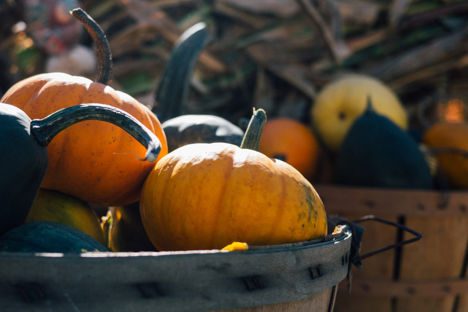
The haunting history of Halloween food
Have you ever wondered why pumpkins are so synonymous with Halloween? Or why we go trick-or-treating? Get spooky with us as we delve into the importance of food at Halloween and suggest some recipes to try this 31st October.
The haunting history of Halloween food
Have you ever wondered why pumpkins are so synonymous with Halloween? Or why we go trick-or-treating? Get spooky with us as we delve into the importance of food at Halloween and suggest some recipes to try this 31st October.
In the UK, we love Halloween. Each year, supermarkets start stocking spooky-themed snacks from September onwards. Of course this is mostly to tempt a younger audience, and those who are excitedly anticipating their annual trick-or-treating. But food has always been an essential part of 31st October, since the Celtic festival of Samhain (pronounced sow-en), from which Halloween originated.
Samhain is still honoured today by modern-day Pagans. Traditionally, on All Hallow’s Eve (more commonly known as Halloween) a Samhain feast is held, during which a seat is left respectfully empty at the head of the table for deceased relatives to occupy, if they’re in the area…
Here, we’ve taken a look at the history of some of the foods which have traditionally been eaten at Halloween over the years and also provided some recipe inspiration for any Halloween feasts you might be hosting!
Pumpkins, squash & root vegetables
Pumpkins are arguably the most recognisable symbol of modern Halloween.
The tradition of carving faces into root vegetables stems from Celtic folklore. Making lanterns and placing them in doorways and windows was said to ward away evil spirits from the home, at a time where the veil between the living and the dead was at its thinnest.
For Samhain, pumpkins and root vegetables were used to decorate altars. Of course, it also made sense to eat these nutrient-dense vegetables as part of the feast, as they were abundantly available at the time of harvest.
Sausages
Historically, in late-September/early-October, meat from farm animals was prepared for the winter and any cuts that were not suitable to be preserved over the colder months would need to be used up rather than wasted. This meant sausages were commonly the centrepiece of Samhain feasts, made with offal and scraps.
Sausages and hot dogs have remained a mainstay of Halloween and Bonfire Night celebrations to this day!
Seasonal fruit
Anything from the last harvest of late-summer fruit would also be prioritised during Samhain, so they didn’t go to waste as the weather turned colder, especially blackberries, pears and apples.
Cutting an apple in half will also reveal a star/pentacle shape in the pips around the core, making them a classic Halloween decoration.
The tradition of bobbing for apples and eating toffee apples at Halloween is another that has persevered through to the modern day.
Sage, rosemary & thyme
Pagans believe that these are powerful herbs. When burned carefully in the home, or eaten, they can build emotional strength and purify a space of any lingering negative energy.
Whether or not you believe in the magical properties of these herbs, they are certainly abundant and at their peak flavour at this time of year, so we’d definitely recommend using them in autumnal dishes at your Halloween dinner party.
Cider & infused spirits
Apples reach their peak seasonality in October. To preserve them through the winter and ensure no waste of the apple harvest, it was traditional to make cider at Samhain, preserving the fruits with alcohol. The same goes for any berries that could be foraged in the hedgerows in September/October.
Modern-day Halloween cocktail menus offer a whole host of extraordinary concoctions, but why not stay traditional and raise a toast this 31st October with your very own hedgerow gin, or a warming mulled cider!
Chocolate & sweets
The true origin of trick-or-treating and eating sweets and chocolate at Halloween is hard to trace. It doesn't seem to be Pagan in origin, instead it was likely started with ‘souling’, a Catholic-created tradition. This seems to be followed by Scottish ‘guising’ and eventually became known as ‘trick-or-treating’ in North America.
However, history books do reference an old Pagan tradition of leaving sweet treats on the doorstep on All Hallow’s Eve, as a way of enticing in the spirits of relatives.
Though this would have been sweet mince meat and candied nuts, we’re certainly on board with the shift towards chocolate and sweets. After all, what better way to get people involved in celebrations than with bucketfuls of confectionery?
Why not bypass the mass-produced supermarket offerings this year and make your own chocolate treats for Halloween?
For further Halloween cookery inspiration, take a look at our dedicated recipe collection.


